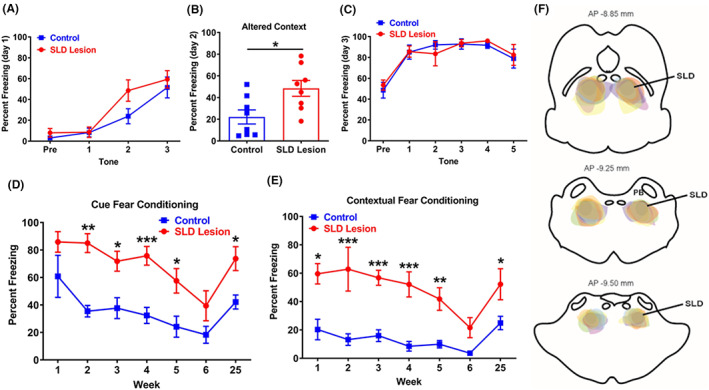FIGURE 4.

REM sleep loss enhances fear memory. To investigate the role of REM sleep in fear memory, we examined and compared the changes between rats with SLD lesions (N = 8) and controls (N = 8) in fear memory consolidation. Rats with SLD lesions and controls were trained for fear acquisition (three tones paired with three shocks) in context A (day 1), and altered context (context B) (day 2) and five tones alone in context A (day 3) and one long tone alone in context A (day 7 and week 2–6, and week 25). Using freezing time to tones (tone freezing) and pre‐tone (contextual freezing) indirectly determines fear memory consolidation. Compared to control rats, rats with loss of REM sleep show non‐significantly higher freezing responses to the second shock and tone in fear acquisition (day 1) (A) and significantly longer freezing time in altered contextual condition in day 2 (B), but no changes in day 3 (C). From week 1 for contextual fear and week 2 for toned fear to week 5, lesioned rats show significantly higher freezing in contextual and cued condition than control by 2.5 and 1.0 fold, respectively (D and E). In week 6, the differences become not significant. Although weekly contextual and tone exposures progressively reduce contextual and cued freezing response in both control and lesioned group, lesioned group still exhibits much higher contextual and cued freezing than that of control. Between week 7 and 24, no tests were given. In week 25, both groups show again parallel higher level of fear responses than that in week 6, with SLD lesioned rats showing significantly higher freezing responses than the control (D and E). Perfused brains confirm that the lesion borders include the SLD marked by lines but avoids the parabrachial nucleus (PB), shown at three levels in (F). The percent freezing in day 2 was analyzed using unpaired t‐test, and others were analyzed using two‐way ANOVA followed by Bonferroni's post hoc test, *p < 0.05, **p < 0.01, ***p < 0.001.
